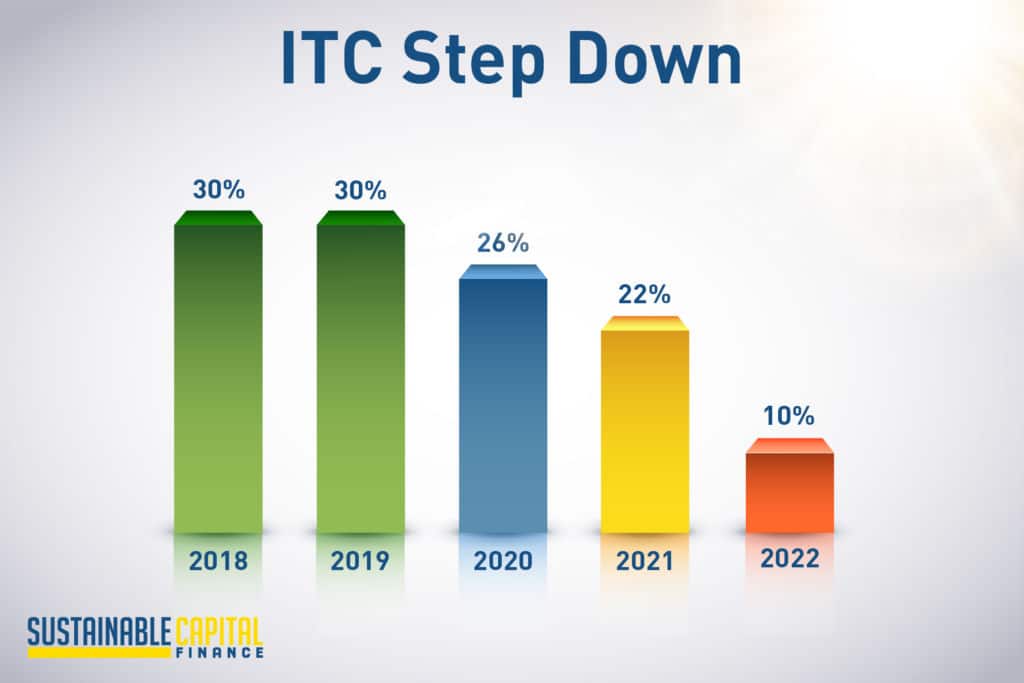Despite ongoing efforts to extend the ITC, 2019 could be the final year of the full 30 percent tax credit, before it steps down in 2020. Based on existing legislation, In 2022 and beyond commercial and utility projects will still have access to the ITC at 10 percent, while residential projects will no longer be eligible for a tax credit.

Before discussing the uncertain future of this monumental program, let’s review its history and impact on the solar industry thus far.
Where and Why Did the ITC Start?
With the goal of encouraging investment and adoption of solar power, the Energy Policy Act of 2005 introduced the Solar Investment Tax Credit (ITC). This groundbreaking program allowed those owning a solar energy system to receive a tax credit, equivalent to 30 percent of the systems eligible cost, although the residential side was capped at $2,000.
In 2008, the bill was saved from expiring by the Emergency Economic Stabilization Act of 2008, often referred to as TARP for the section pertaining to renewables. This act also removed the $2,000 cap on residential ITC.
Further legislative action preserved the bill from its previous step down date of 2017, when Congress signed off on a bill which extended the solar investment tax credit by another five years, part of a 1.15 trillion spending bill.
How the ITC has Affected the Solar Industry
Proving to be one of the strongest success stories in energy policy, the ITC has spurred both distributed and utility-scale solar deployment across the nation. Up until the ITC launch, the yearly number of new solar installations in the U.S. was sub-200. Post ITC, that number grew by an impressive amount year over year, with over 2,400 new installations in 2018.
According to reports from SEIA:
“The residential and commercial solar ITC has helped the U.S. solar industry grow by more than 10,000% percent since it was implemented in 2006, with an average annual growth of 50% over the last decade alone.“
Not only have there been record numbers of solar projects installed since the ITC’s introduction, the solar industry has also grown to become a major supplier of jobs in the U.S., expanding by 86% as a jobs provider since data was first recorded in 2010.
What’s Next for the ITC and How Will This Affect the Industry?
A group of bipartisan lawmakers recently introduced legislation which would extend the ITC at 30 percent for another five years, an extension that would help the solar market to continue its rapid growth. While this would be a welcome boon to the sector, it could also cause disruptions for those planning for its decline in 2020.
If an extension is not passed, the industry will need to focus on continuing to lower costs in order to make up for its previous reliance on tax incentives. Fortunately, the commercial and utility-scale industry will still be able to rely upon the ITC, with the step down bottoming out at 10 percent.
Regardless of the results in congress, businesses and developers interested in going solar that have not yet achieved commercial operation on existing projects, would be best served by beginning construction on projects before the end of 2019.
How SCF Can Help You Leverage the ITC Before Step Down
As we enter August in 2019, SCF is encouraging its partners to submit PPA opportunities for review and preliminary terms, with an execution plan to achieve COD in 2019, or at a minimum, commence construction.
If you are unsure a project can meet such a tight development window, we can provide 2020 COD terms as well.
Please don’t hesitate to reach out to us with any questions regarding 2019 PPAs.






